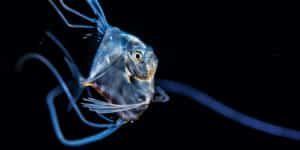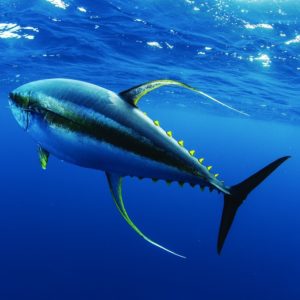“Fighting Time.” That’s one of the blanks on the International Game Fish Association’s record-application form that must be completed when submitting a catch for world-record consideration.
While foremost factors are the species and line (or tippet) class, in some cases the time it took an angler to bring in a record fish can be of interest, hence this look at a few of the shortest and longest fight times for generally large fish.
It should be noted that however long the catch took (from hookup to grabbing the leader at the boat), all of these records were approved only after the IGFA ascertained that no angling rules were broken in the capture of a fish.
Often with the application form in the record folder are letters from the angler, crew and witnesses offering additional information or testimony. That’s particularly true when catches are outlandishly quick. But most of those are made by anglers out to set records, with a crew well-prepared to act quickly and decisively once a potential-record fish is hooked.
However, some “instant catches” are more serendipitous than calculated, as was the case with the two‑minute world-record tuna.
Monster Yellowfin in 120 Seconds
The very thought of battling — especially stand-up from a dead boat — a 388.5-pound yellowfin tuna is enough to make most bodies ache. But for Curt Wiesenhutter on April 1 (no fooling), 1977, there wasn’t time enough to experience any pain, nor much strain.
Landing a yellowfin approaching 400 pounds would be a formidable task in even an optimal situation. But on a drifting San Diego-based long-range boat (Royal Polaris, in this case), among dozens of lines in the water around a rail high above the water, where an angler can’t easily follow a fish around the boat on his own, you might figure landing such a behemoth would be impossible.
Whether the catch was “sporting” is subjective, but the IGFA — after months of investigating and correspondence with the angler, captain (the late, legendary Bill Poole) and others — determined that the fish was landed without breaking any rules; it became the all-tackle world record at that time, and it’s still the men’s 80-pound record today.

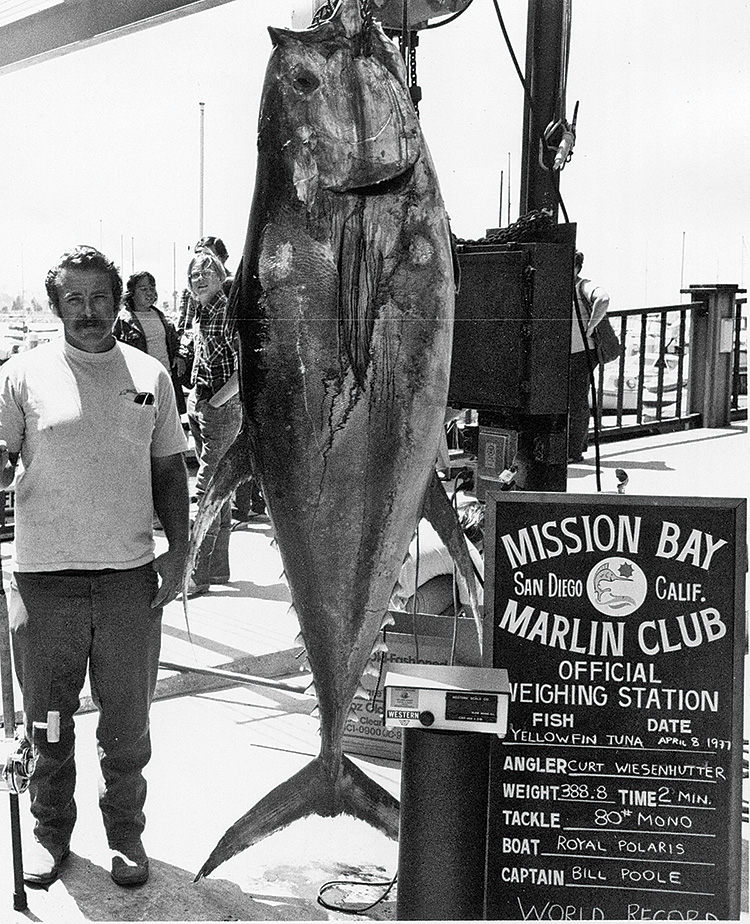
Here’s how it went down.
Wiesenhutter was soaking a live caballito (scad — a Pacific goggle-eye) off the port side of the 115-foot long-range boat when he was bit and then, as they say in California, bendo. In a letter to the IGFA, the angler explains, “The fish took 40 to 60 yards of line, then turned back at the boat.” It circled near the boat and darted under it, coming up on the other side.
His friend, Larry Ward, fishing in the starboard corner 30 feet across from the port side, said he looked over the rail and saw the huge tuna for whatever reason “laying on its side, splashing” water as high as the rails. Ward yelled that it looked like a record fish.
By then, Poole was on deck and had gaffed the fish, but many more hands were required to bring it up the boat’s high sides, so three more crew/anglers (including Wiesenhutter, who apparently had set down his rod in free-spool), stuck the fish with gaffs, and eventually the group had the monster on the deck.
On August 30, 1977, IGFA president Elwood K. Harry wrote to Wiesenhutter to say his catch “now holds the all-tackle and men’s 80-pound-line-class world record.”
That did little to quell the raging (within the angling world, particularly in Southern California) controversy surrounding the catch. San Diego fishing writer Chuck Garrison reported that Wiesenhutter acknowledged, “I have very mixed emotions about [this record].” But a record it remains.
Tarpon: A Tale of Two Records — one of Minutes and one of Hours
Angler Thane Morgan is proof that every fish, and the circumstances at the time, determines how a light-line battle will go down. The one fairly reliable prospect of such battles is that they will defy expectations, and often ruin the most carefully laid plans.
Morgan’s battles with two current tarpon records, in 2011 and 2013, couldn’t have been more different.
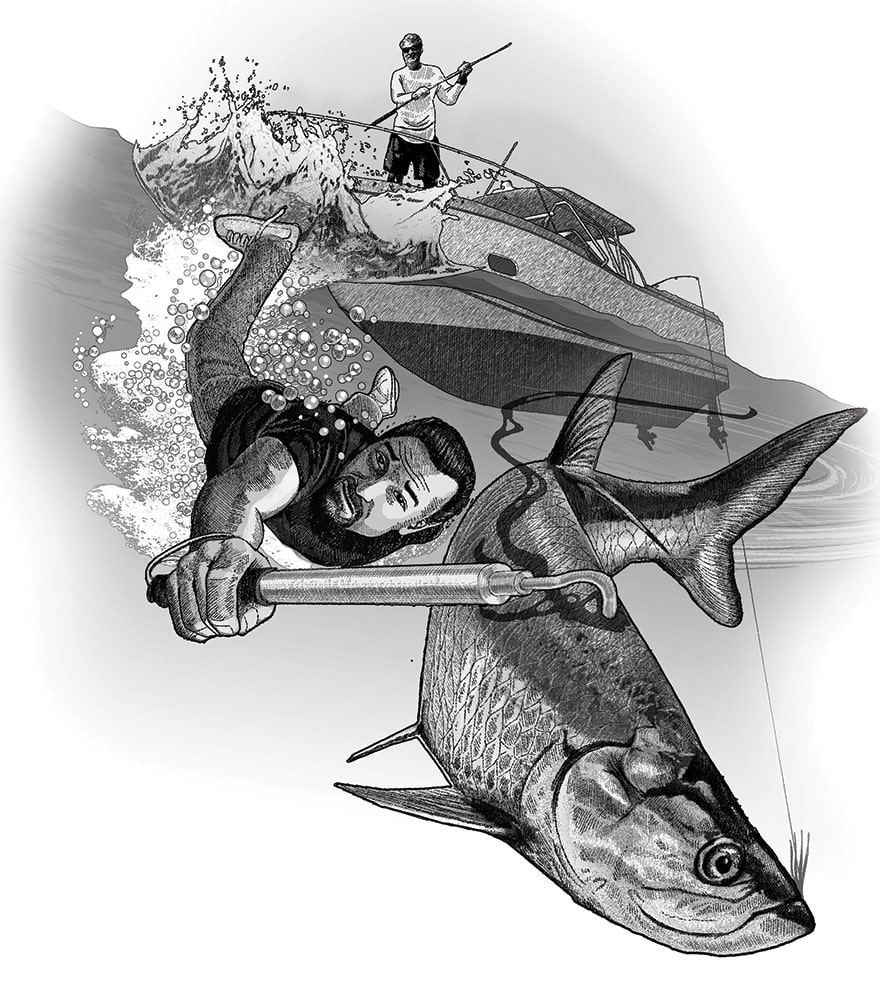
The Amarillo, Texas, angler never expected to land one record fish in just three minutes nor to fight one slightly smaller for six hours.
Fishing with his friend Capt. Dustin Huff — son of famed Florida Keys guide Steve Huff — Morgan was determined to set a new IGFA fly-rod record for tarpon on 4-pound tippet and did, with a 119-pounder.
“We’d probably hooked a hundred on 4 that we never landed,” Morgan says. That changed on October 13, 2013, near Marathon in the Keys, when the angler put a mullet fly in the path of yet another big tarpon. At the sting of the hook, it “went crazy, jumping,” says Morgan. No big surprise there, but the pair was surprised when the tarpon “basically belly-flopped and came down stunned.”
They quickly ran up on the fish and put a gaff in it. At that, the tarpon took off, and took Huff with it, pulling him over the side and dragging him behind, Morgan says. Huff wasn’t about to let go. In about three minutes from when the fish was hooked, it was in the boat.
(Morgan had, of course, paid for the tag necessary to boat a tarpon because he was explicitly fishing for a world record.)
Two years earlier, fishing with Huff, Morgan boated an 88-pounder on 4-pound that overtested, so it became and remains the 6-pound world record. However, that fish required not minutes to land, but hours — 18 in total.
At about 4 p.m., in outer Florida Bay, Morgan hooked a large tarpon on 4-pound line. Sometime late in the day, they discovered the gaff point had been rolled. So while Morgan fought the fish, Huff ran the boat while trying desperately to sharpen the gaff point using the only thing they had — a little fish-hook file.
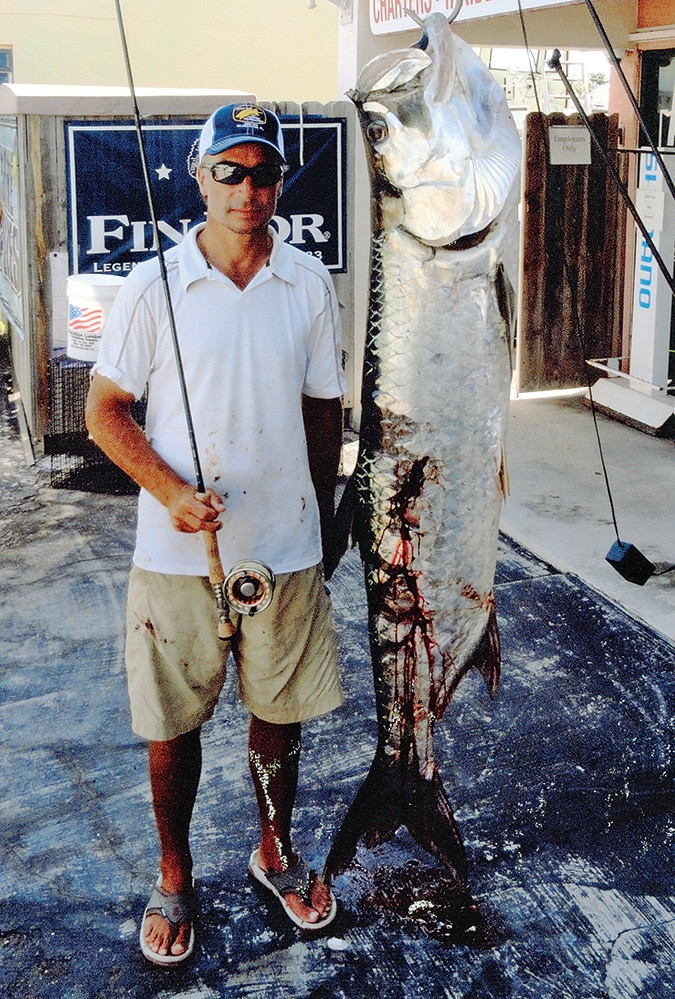
Even with a good gaff, a big tarpon is hard to stick. In this case, “We probably hit it 12 times through the course of the night,” says Morgan. Three times during the night, the tarpon laid up on bottom in the Man O’ War Channel. On 4-pound tippet, it became an immovable object, Morgan says.
Finally, at noon the next day, 15 miles from where it was hooked, the pair subdued the fish.
The bad news for Morgan: The line overtested. The good news: Breaking at 5.2 pounds put it into the 6-pound-tippet category, breaking Stu Apte’s existing world record for that class, so it became a world record after all.
Seven Hours on a Bigeye
In 1986, legendary angler Stewart Campbell and Capt. Bark Garnsey ventured to Africa’s Ivory Coast to fish for blue marlin. At that time, they didn’t have a boat, so “we just kind of borrowed a guy’s boat. But the price was that he came with us.”
The boat, its setup and its tackle weren’t really conducive to pitch-baiting, as they preferred, so they just trolled small lures on his outriggers, says Garnsey, on 30-pound line.
With marlin in mind, they hooked a triple — of bigeye tuna.
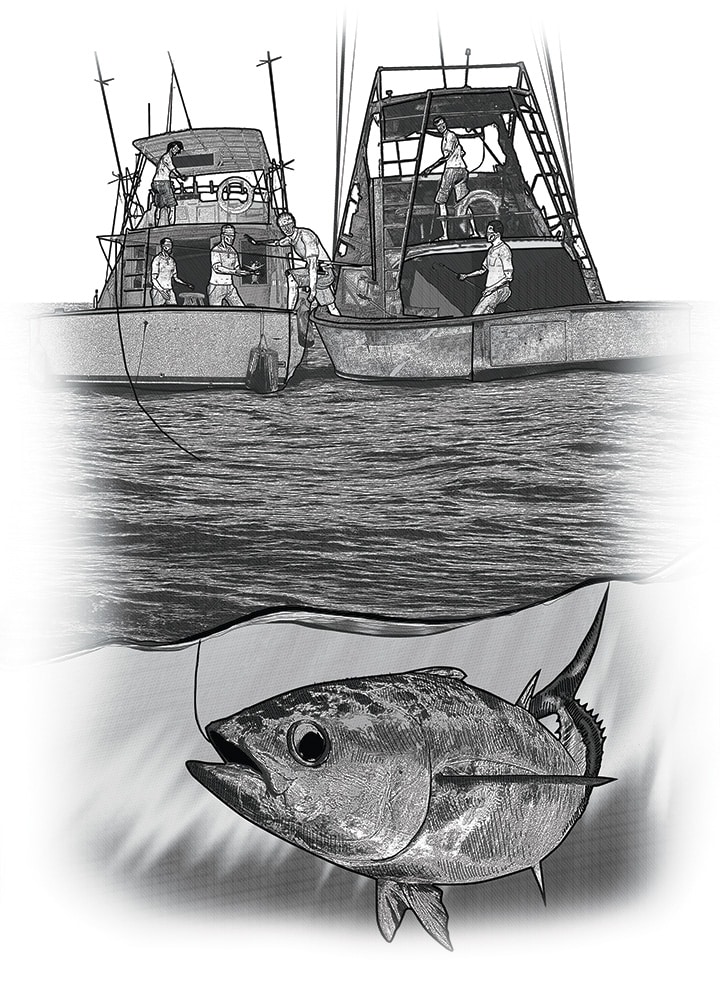
They purposely broke off one in hopes of managing the double, but of course, the big fish wishboned the pair of anglers — Campbell and the boat owner.
In order to follow the boat owner’s fish, Garnsey says, “we put Stewart on a French guy’s boat.”
Fortunately, the seas were calm, but it was still a tricky transition, with Campbell holding the rod under his arm as he climbed aboard and Garnsey yelling at the crew, who were trying to be helpful, not to grab the rod.
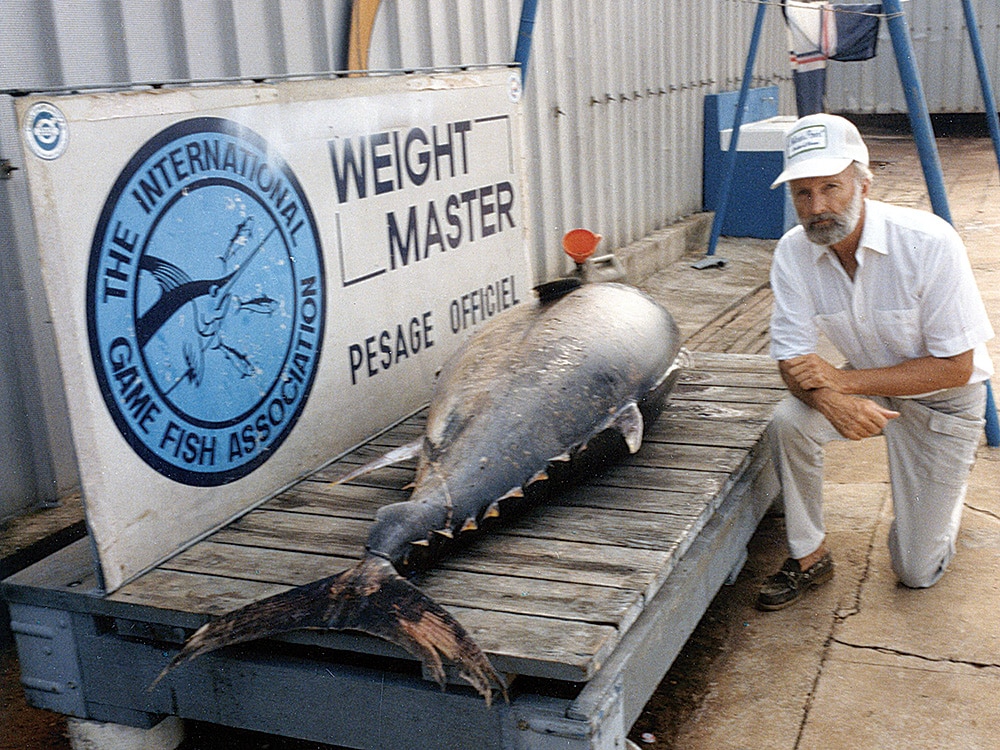
Eventually, Campbell climbed back onto the original boat after the owner ended up losing his tuna, and finished the fight from there.
“When we finally got the fish in the boat,” Garnsey says, “it was almost dark. That was the first bigeye I’d seen at that time.
“I asked Pete Gray, who was with us, what he figured the world record for a bigeye on 30-pound might be. We ended up calling the marlin club in Abidjan and found it was around 240 pounds.” That made their 329-pounder the line-class record, as it remains to this day.
How did Campbell hold up over the course of that tough seven-hour battle? “He was bionic,” says Garnsey, noting that he later saw Campbell through much longer fights, including an estimated 750 blue on 16-pound line. Ultimately, that fish came up in the darkness under the boat and jumped, breaking off right there. That, Garnsey says, was a real heartbreaker.
The One-Minute Marlin
How does an angler come to land a 226.5-pound marlin in a minute? One instance happened this way.
Saundra McMurray, at that time of Fort Lauderdale, Florida, was fishing out of Los Sueños Resort off Costa Rica on February 19, 2002, on the 63-foot American Custom Stephanie Lee. Aboard were Capt. Tony Carrizosa and three mates. McMurray was loaded for bear — with the equivalent of a high-quality peashooter, her Shimano TLD 20 filled with 6-pound line. Obviously, McMurray and her crew were out to break a world record.
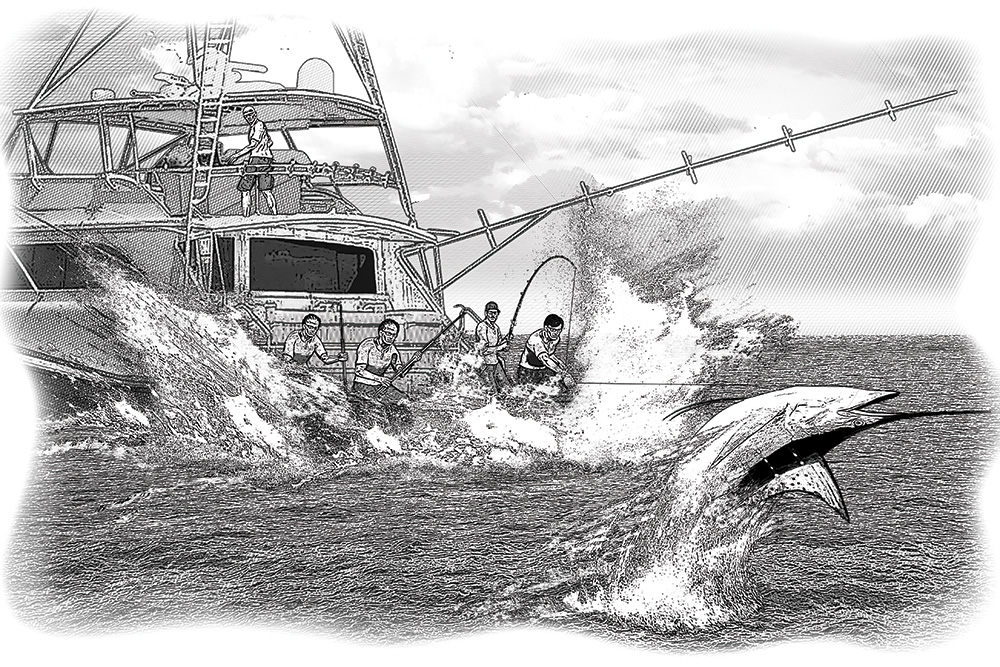
Around 1 p.m., the stripe came up on the right-short teaser. “I picked up the [pitch-bait] rod and pitched back a mackerel rigged with a circle hook,” writes the angler in her letter to then-IGFA president Mike Leech to explain the circumstances.
The fish whacked the bait, then circled and came back to hit it again. “I let him run, then locked up the reel. As soon as he knew the fish was hooked, Tony threw the boat in reverse, and I wound as fast as I could as the boat was flying backward toward the fish.” The marlin was “windshield-wipering” (thrusting its head side to side above the water) as the boat came back to it, says mate Barry Gottlieb.
In seconds, McMurray had wound the leader to the rod tip, and one of the mates grabbed the leader, yelling, “Caught fish!” By IGFA rules, of course, that was so. Two other mates, already standing by, immediately put gaffs into the fish, and Carrizosa, who had rushed down into the cockpit, added a third gaff.
The fish was caught and now boated.
Hard to imagine? The IGFA didn’t have to imagine any part of it: The angler provided video that showed the whole very fast and furious moment.
Sharks, Blues and Permit
The five catches described above by no means represent all of the exceptionally brief or extended battles with record game fish. Here’s the short version of a few others.
BLUE SHARK, 7 HOURS
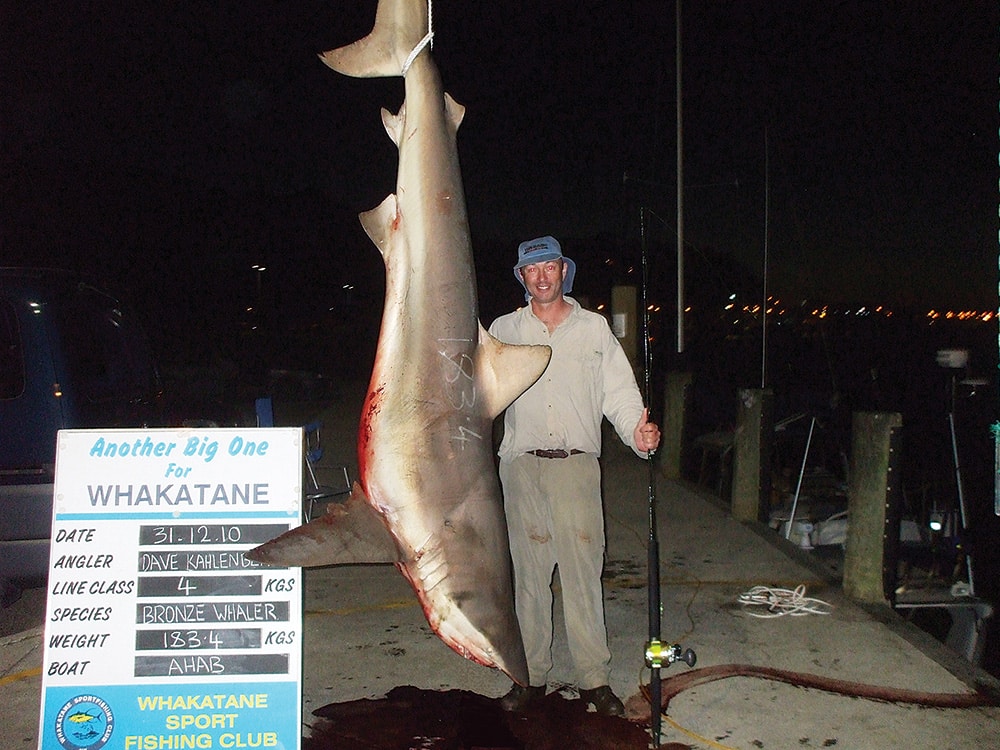
After spotting two big bronze whaler sharks lurking in the burley (chum) trail, Dave Kahlenberg, of Rotorua, New Zealand, drifted a bait back to them. He was fishing 8-pound line mono on a Tiagra 12, hoping to beat the 130-pound line-class record. The shark took; the angler set and then held on as the fish made a screaming 100-yard run. Then began the long battle. After several grueling hours, the fish cleared the water in a number of surprisingly high leaps. But it wasn’t until more than seven hours had elapsed, 12 or so miles from where they’d hooked up and far into the night, that Kahlenberg and his mate finally managed to get the shark on the swim platform. The record catch on 8-pound line in December 2010 weighed in at more than 400 pounds.
BIGEYE TUNA, 57 SECONDS
“I remember that fish coming in on the left long,” says Capt. Jason Pipe of that June day in 2008 off La Gomera, Canary Islands. “That fish” would go on to be the men’s 6-pound-test world record once the 357-pound blue marlin was weighed in. Angler Gary Carter put a pitch bait in front of the fish, and it was hooked. The marlin jumped, coming straight up, then began thrashing as Pipe thrust the 37 Bertram Bocinegro in full back-down mode. The blue came out again, “and mate Jason Brice took his gaff shot and nailed her in midair, right in the arse!” Pipe recalls. Mayhem ensued, but eventually the fish was subdued. Pipe recalls the time from hookup to the mate grabbing the leader as exactly 57 seconds.
PERMIT, FIVE HOURS
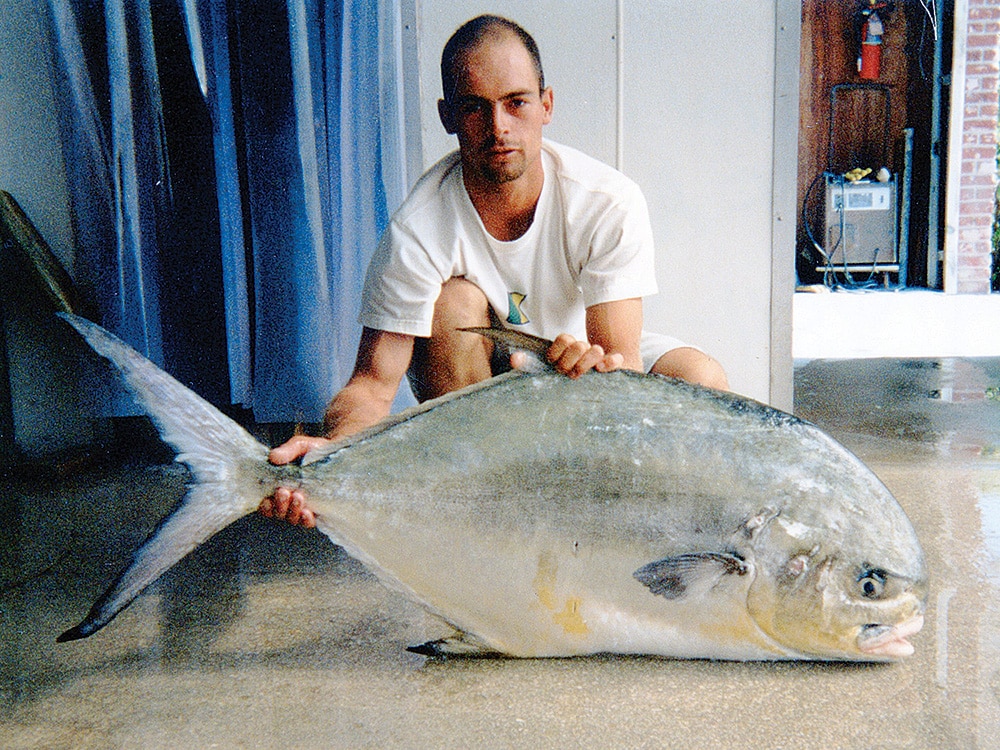
Fishing for a world record was about the furthest thing from the thoughts of Tom Sebestyen, of Deerfield Beach, Florida. In fact, he was just fishing for live baits with sabikis off Fort Lauderdale. When a couple of big, fast-moving fish went around his boat, Sebestyen grabbed a spinning rod that had on it the little yellow bucktail jig he used for blue runners. He tipped it with a piece of shrimp and cast in front of the fish. He saw the shape follow the jig down, then came tight on it, and instantly it was ripping drag, so Sebestyen and his pal Mike followed — and followed. Sebestyen says he kept a light drag and just persisted. During the dogged fight, Mike cast out liveys and caught a couple of nice kings. At 10 p.m., roughly five hours after the hookup, the pair landed the all-tackle world-record permit of 56 pounds, 2 ounces (since defeated, but the catch remains the men’s 20-pound-class record).

